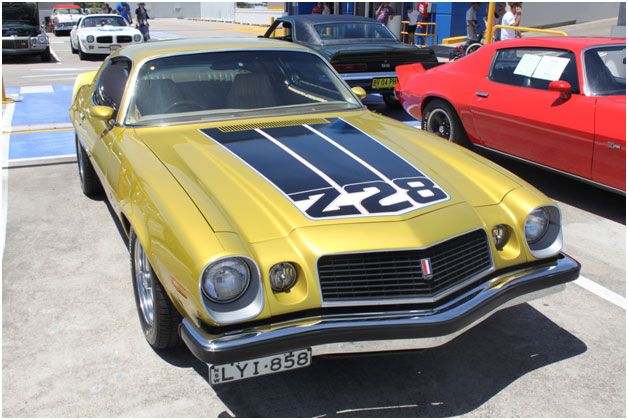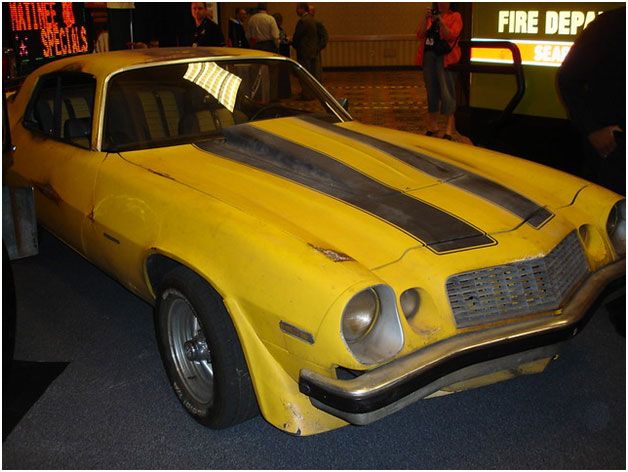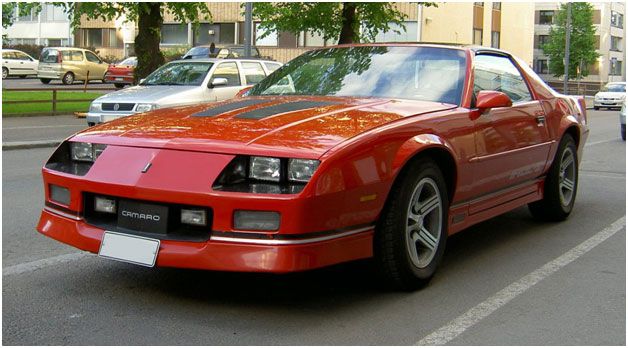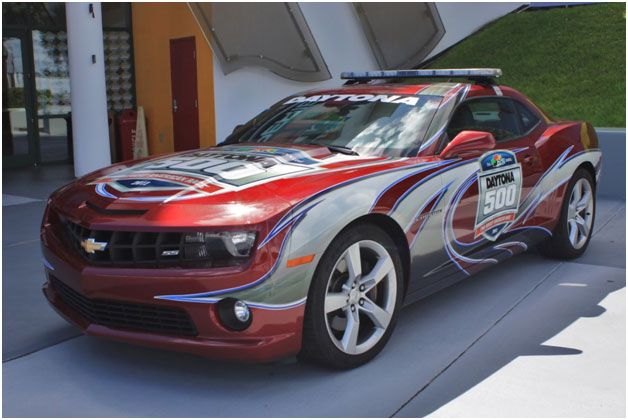
America’s Muscle Car: The Chevy Camaro
Image Credit: Joseph82 / Pixabay
Written By John Linden
In one episode of Comedians in Cars Getting Coffee, noted car aficionado Jerry Seinfeld picks up Eddie Murphy to go for coffee and a drive. Seinfeld likes to match his cars with his guest comedians, so he spared no expense for Murphy, driving his decked-out 2004 Porsche Carrera GT. A street-legal race car, the fully optioned version of this Carrera can bring an asking price of over $900,000.
Despite driving around in a museum piece of German manufacturing, when Seinfeld asks Murphy what his favorite car is, the choice comes without hesitation:
“The Camaro. ’76.”
One of America’s most iconic and trendsetting cars, the Camaro helped shape America’s vision of what a sports car could be. Even today, this iconic car symbolizes freedom, potential and power. It captured the imagination like few cars before or since.
The Chevy Camaro - American icon
In the heart of one of America’s most tumultuous summers, Chevrolet revealed its plans to disrupt America’s car industry. Chevy released a brief series of mysterious press releases that implied they would release a car named after a cat that could take down a Mustang. At the time, Ford’s muscle car was the leading sports model.
After being produced in secrecy in their Norwood, Ohio plant, on September 29, 1967,Chevrolet unveiled the Camaro, a car so unique that it is not, in fact, named after anything.
Figure 1: Restored 1967 Camaro SS. Photo credit: Rudolf Periny / Wikimedia Commons [Public domain]

This first round of Camaros were four-seaters with a single-frame design and a flexible power-station housing. Featuring two models, the sport coupe and the convertible, the design was intended to be suitable for holding multiple engine options. Ultimately 60 factory options existed, including 4 separate engine choices ranging from 250cc to a 398cc V8.
One of these options was marked on dealer order sheets as the Z28. This was initially a code indicating a “Special Performance Package.” In addition to a host of special features for engine performance, trim, and stability and braking, this was the only model that could be certified for stock racing. Only 600 were sold that first year.
The Z28 would go on to become the most recognized and celebrated Camaro over the years.
The Camaro makes its mark on America
As anticipated, the Camaro instantly challenged the Mustang in sales. It also sought to match it in mystique. The popular and trendy new car found its way into popular movies and the most famous races, and thus into the national zeitgeist.
In 1967 and in 1969, the special performance model Z28 was chosen as the pace car for the Indianapolis 500. This placement at the heart of America’s iconic race gave the model a boost in recognition and credibility and helped it challenge the Mustang in sales.
The Z28 entered the SCCA Trans-Am racing series in 1967 as well. Arguably, though, the 1967 model’s wins in the NHRA Super Stock drag racing series are what solidified the Camaro in US racing lore.
The 1974 Z28 was redesigned to meet new federal safety standards involving the height and strength of bumpers.
Figure 2: The 1974 Z28 was redesigned to meet new federal safety standards for bumpers. Photo credit: Jeremy from Sydney, Australia [CC BY 2.0 (https://creativecommons.org/licenses/by/2.0)]

In 1971, Road and Track named the Camaro one of the ten best cars in the world. This cemented Chevy’s muscle car at the forefront of American engineering and performance, and marked the establishment not of a flash-in-the-pan, but of a true American icon.
The Camaro would go on to star in movies, red-carpet events, and music videos. The recent movie Bumblebee featured the titular transformer becoming not just one, but two different yellow Camaros, a 1970’s version pictured below, and the 2016 model.
Figure 3: The first Bumblebee car – Image credit: Mike Renlund / Flickr

First 4 generations
The Camaro’s first run featured four distinct generations.
Of course there was the classic primary release, a body style and feature set that lasted from 1967 to 1969 and caught the world’s attention. But in the ever-changing industry of automobile design and innovation, a new Camaro was on the drawing board as soon as the first one drove off the assembly line.
From 1970 until 1981, the second generation Camaro underwent modifications, largely cosmetic, based on the same uni-body frame. Of course this included the bumpers – controversial at the time – mandated by federal law.
It was at the end of this generation that Chevrolet added a classic Camaro touch. The 1980 and 1981 models included a sport option for a visually iconic air induction hood scoop. This modification added heft and muscle to the car’s appearance. However, as with all things Camaro, the real value was under the hood.
Figure 4: Hood scoop circa 1973. Photo credit: BrokenSphere [CC BY-SA 3.0 (https://creativecommons.org/licenses/by-sa/3.0)]

When the driver put the pedal to the metal for full acceleration, the hood scoop opened, allowing the engine to gulp more oxygen and promoting more efficient fuel burn. It was the automotive equivalent of a bulging bicep. Sure it looked great, but the power was in the performance.
The third generation Camaro generally encompasses 1982-1992 and includes some designs that draw attention. Perhaps the most iconic Camaro in this generation was the pulse-pounding 1985 IROC-Z. Featuring a seductive rear-frame lip spoiler and an aerodynamic wedge shape, the IROC-Z was also featured in the Camaro’s more modern return to the Chevy lineup.
Figure 5. Red IROC Z caught in an unusual position – at rest. Photo credit: M62 [CC BY-SA 3.0 (http://creativecommons.org/licenses/by-sa/3.0/)]

The fourth generation of Chevrolet Camaros featured an expansion of the options available to the consumer. Chevy attempted to capitalize in the appeal of the Camaro and reach into a broader audience by updating the F-body platform, allowing the T-top and convertible options, and even offering an expanded 5-speed manual or 6-speed automatic transmission.
Despite this broadening of options, or – some might argue – because of it, the Camaro’s heyday seemed to have passed. Chevrolet cited declining sales and increased focus on fuel efficiency as reasons for the decline in the Camaro’s popularity.
Ultimately the dual threat of slowing sales and overproduction led to the end of an era. What many believed would be the last Camaro rolled off the production line in 2002.It seemed to be a sad end to a car that had already written its name in America’s lore.
The Chevy Camaro Resurrection
If that had been the end of the Camaro, it would remain an impressive part of the American love affair with the car. Star of movies, driveways, side street races, and oval championships, the Camaro was a legend. Tributes poured out for a car that had won many hearts and who, like an aging celebrity whose best roles were behind, the car seemed destined to fade into our collective memories.
However, a second wave was coming. The muscle car famous for redesigns and innovations had another trick up its sleeve – a form of resurrection.
In 2005 Chevrolet determined internally that the Camaro deserved a second shot and would be receiving a new design. This final design was approved and announced to the press in 2006.
After 7 years out of production, and once believed to be part of a bygone era, the Camaro was back. The first edition of the new look car, produced in Canada, rolled off the assembly line in the spring of 2009.
Generation five of the Camaro ran from 2010 until 2015, and in many ways improved upon the car’s legend.
In 2010 the new Camaro stormed the World Car Awards, winning the prestigious World Car Design of the Year. Welcome back! Originally intended as a limited release, this award and other recognition, perhaps fueled by a nostalgia for one of America’s iconic cars, prompted unexpected demand. A schedule 2011 redesign was rescheduled.
For the next several years, this and subsequent Camaro redesigns found their way back into America’s premier races.
The 2011 Daytona 500 had a Camaro as its pace car, pictured below.
Figure 6: The Daytona 500 pace car: a 2011 Camaro. Photo credit: Nick Ares [CC BY-SA 2.0 (https://creativecommons.org/licenses/by-sa/2.0)]

Various Camaro models took to the brickyard as well, pacing the Indianapolis 500 in a short span of time. Specifically, 5 models paced the race over 7 years:
- Year: 2009; Model: 2010 Camaro
- Year: 2010; Model: 2010 Camaro SS
- Year: 2011; Model: 2011 Camaro convertible
- Year: 2014; Model: 2014 Z28
- Year: 2016; Model: 2017 Camaro SS
The 2016 Indianapolis pace car was not just any Camaro. This model marked 50 years since the inception of the Camaro, and a major milestone in Chevrolet history. They marked the occasion by building a 50th anniversary special edition Camaro SS to pace the race.
The Camaro legend lives on
Though slowed by our nation’s massive recession, a government bailout allowed Chevrolet to continue into 2009 and 2010. In the years that followed, the Camaro legend was burnished by even more awards and accomplishments.
As befits a car with the heart of an everyman, the Camaro came through the recession stronger than ever. Generation 6, the present generation, was named 2016 Motor Trend Car of the Year. The RS model packed 335 HP into a smoothly calibrated 8-speed automatic transmission which prompted the editors to say of Chevrolet, “Boy howdy, did they ever deliver”!
They called the new design “excellent” with a nimble and muscular appearance. The editors also commented that it could have / should have won the best driver’s car as well. Taking in its appearance but commenting mostly on its performance, Motor Trend cemented the Camaro’s place in modern car history.
With this impressive award under its belt, Chevy could have rested on its laurels. Instead, they beefed up the racing side and redoubled their efforts in America’s iconic stock car race.
In 2018 the work paid off as the legendary street car once again flexed its muscles on the oval. Austin Dillon drove the Camaro ZL1 to a victory in the Daytona 500. (Worth noting: Darrell Wallace Jr. came in second, giving Chevrolet a memorable, if not historic, 1-2 finish.)
Figure 7: Dillon's 2018 Chevrolet Camaro, not available in stores. Image credit: Zach Catanzareti Photo [CC BY-SA 2.0 (https://creativecommons.org/licenses/by-sa/2.0)]

The Chevrolet Camaro has raced, rocked, and rolled its way into American car lore. On the oval and in the driveway it has been impressing judges and your neighbors for over 50 years. Protect yourChevrolet Bel Air with our high-quality covers.
It is poised for a second half-century of automotive glory.
Updated